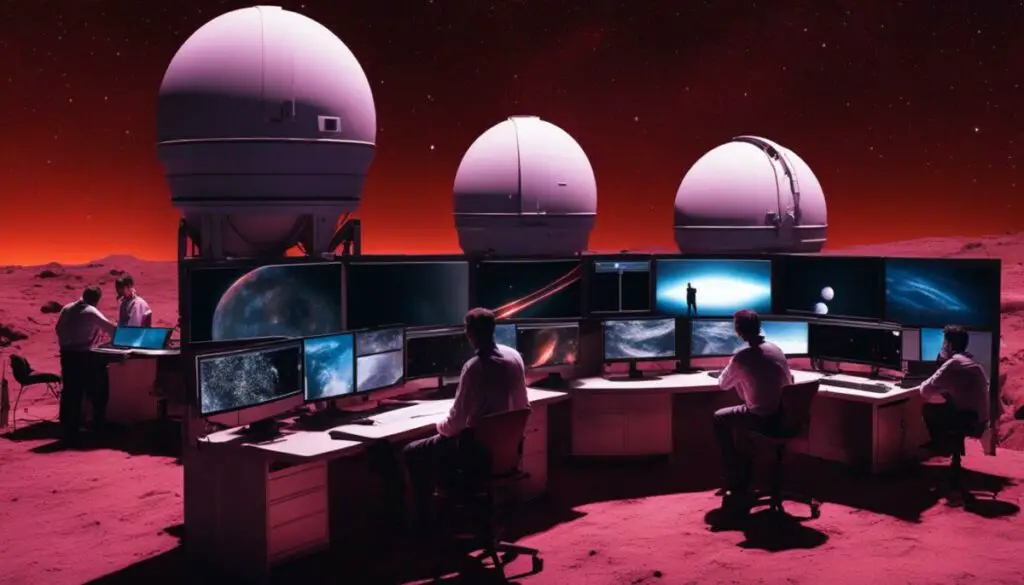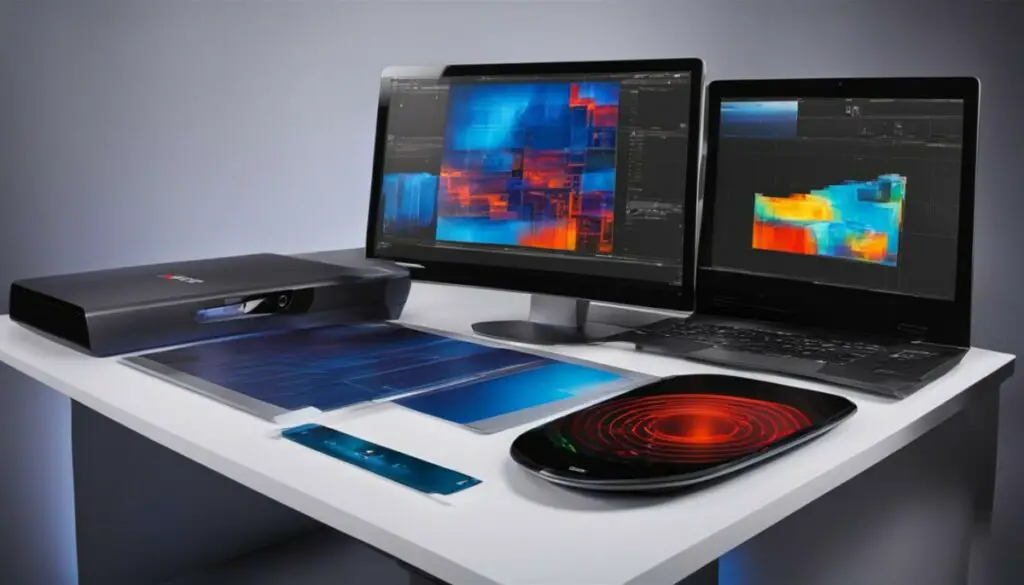Last Updated on 5 months by Francis
Have you ever wondered if infrared LEDs are visible to the naked eye? It’s a fascinating question that has puzzled many. Well, tonight we will delve into the mystery and uncover the truth about the visibility of infrared LEDs.
Infrared light, which is used by devices like the James Webb Space Telescope, is invisible to the human eye. Astronomers have captured incredible details of the Milky Way galaxy using this technology, proving that infrared LEDs are indeed not visible to us without specialized equipment.
Contents
Key Takeaways:
- Infrared LEDs are not visible to the naked eye.
- Specialized equipment is required to detect infrared LEDs.
- The James Webb Space Telescope has revolutionized our understanding of the universe through its infrared observations.
- Infrared technology has revolutionized various fields, including astronomy and medical imaging.
- Advancements in infrared technology promise a future of further discoveries and applications.
The Electromagnetic Spectrum and Infrared Light

The electromagnetic spectrum is a range of light waves that encompasses various forms of energy. One important component of the spectrum is infrared light, which lies beyond the range of visible light. Infrared light has longer wavelengths than visible light, making it invisible to the human eye.
Within the infrared light spectrum, there are different regions, including near-infrared and mid-infrared. Near-infrared light has shorter wavelengths and is closest to the visible light range, while mid-infrared light has longer wavelengths and is closer to the microwave region of the spectrum.
Telescopes like the James Webb Space Telescope are specifically designed to detect and observe infrared light. By capturing and analyzing this invisible light, astronomers can gain valuable insights into celestial objects and phenomena that emit little or no visible light. Infrared observations have revealed hidden regions of star formation, distant galaxies, and even the early stages of the universe.
Infrared vs. Visible Light Wavelengths
To better understand the differences between infrared light and visible light, let’s compare their wavelengths in a table:
| Light Type | Wavelength Range |
|---|---|
| Visible Light | Approximately 400 to 700 nanometers |
| Near-Infrared | Approximately 700 to 1400 nanometers |
| Mid-Infrared | Approximately 1400 to 3000 nanometers |
As shown in the table, visible light has wavelengths ranging from approximately 400 to 700 nanometers, while near-infrared light extends from approximately 700 to 1400 nanometers. Mid-infrared light has even longer wavelengths, ranging from approximately 1400 to 3000 nanometers.
These differences in wavelengths determine the detectability of light by the human eye. While we can perceive visible light through our natural vision, infrared light remains invisible without the aid of specialized equipment.
“Infrared light, with its longer wavelengths, reveals hidden details and allows us to explore the unseen world of celestial objects.”
The Unseen World of Infrared Light

Infrared light detection plays a crucial role in various fields, including astronomy, imaging, and technology. Infrared cameras and sensors are used to capture images and gather data in industries such as surveillance, night vision, and medical imaging. Infrared technology enables the detection of heat and various materials that emit infrared radiation. While infrared light is invisible to the human eye, its detection and application have revolutionized many fields.
One of the key applications of infrared technology is infrared imaging. By using specialized cameras that can detect infrared radiation, detailed images can be captured even in low-light or obscured environments. Infrared imaging is used in fields such as law enforcement, where it can help locate suspects in the dark, and in the medical field, where it can assist in diagnosing medical conditions. Additionally, infrared technology is utilized in thermal imaging, allowing for the detection of heat signatures and temperature variations.
“Infrared technology has not only enhanced our ability to see the unseen, but it has also opened up new avenues for scientific research and exploration,” says Dr. Jane Thompson, an expert in infrared imaging. “We can now study objects and phenomena that were once invisible to us, providing valuable insights into various fields.”
The Future of Infrared Technology
As technology continues to advance, the future of infrared technology looks promising. Ongoing research and development efforts focus on improving the sensitivity and resolution of infrared detectors, enabling even more detailed and accurate observations. This opens up new possibilities for applications in fields such as environmental monitoring, aerospace, and industrial inspections.
In conclusion, the unseen world of infrared light has become increasingly visible and accessible thanks to the advancements in infrared technology. The ability to detect and utilize infrared radiation has revolutionized various fields, from astronomy to medical imaging. As technology continues to evolve, we can expect further discoveries and applications that will expand our understanding of the invisible realm of infrared light.
Infrared LEDs and Their Functionality
When it comes to the fascinating world of infrared technology, one component that stands out is the infrared light-emitting diode, or infrared LED. These LEDs are unique in that they emit infrared light when an electric current is applied to them. Through their functionality, infrared LEDs have found a wide range of applications across various industries.
Infrared LEDs are commonly used in night vision cameras, where they provide the necessary illumination for capturing clear images in low-light conditions. They are also utilized in remote controls, allowing us to conveniently operate our electronic devices from a distance. Additionally, infrared LED sensors play a crucial role in proximity sensors, motion detectors, and temperature sensors, enabling the detection of objects and changes in the surrounding environment.
One area where infrared LED technology has made significant advancements is in the field of communication devices. Infrared LEDs are utilized as transmitters in devices like wireless headphones and printers, allowing for efficient and reliable data transmission. Furthermore, infrared LED lighting has become increasingly popular for its energy efficiency and durability, making it a preferred choice in various indoor and outdoor lighting applications.
The Versatility of Infrared LEDs
From enhancing security systems to improving automotive sensors and healthcare devices, the versatility of infrared LEDs knows no bounds. These powerful components enable the development of advanced technologies and solutions that enhance our lives in numerous ways. As infrared LED technology continues to evolve, we can expect to see even more innovative applications and further integration into various industries.
The Human Eye and Infrared Perception

The human eye is a remarkable organ capable of detecting a wide range of colors within the visible spectrum. However, when it comes to infrared light, our eyes fall short. Infrared light, with its longer wavelengths, lies beyond the range of visible light, rendering it invisible to human perception. This inability to see infrared light is due to the fact that our eyes lack the necessary receptors to detect these wavelengths.
While humans cannot naturally perceive infrared light, there are other creatures in the animal kingdom that possess this ability. For example, certain snakes have specialized pit organs that are sensitive to infrared radiation, allowing them to detect the body heat of their prey. However, humans are not completely left in the dark. Through the use of specialized equipment such as infrared cameras or goggles, we can visualize and detect infrared radiation.
These technological advancements have paved the way for numerous applications. Infrared cameras, for instance, are used in surveillance systems, enabling us to see in the dark and detect hidden objects. In the field of medicine, infrared imaging techniques allow us to visualize areas of inflammation or detect tumors. Infrared technology has also found its way into the automotive industry, where it is used in sensors for driver-assistance systems.
“While human eyes cannot see infrared light, our ingenuity and technological advancements have allowed us to harness its power and unlock a world of possibilities.”
So, although the human eye cannot naturally perceive infrared light, our ability to develop and utilize innovative technologies has opened up new frontiers of exploration and discovery. By expanding our understanding of infrared perception and pushing the boundaries of infrared technology, we continue to unveil the hidden beauty and potential that lie within this invisible realm.
The James Webb Space Telescope and Infrared Discoveries

The James Webb Space Telescope (JWST) has revolutionized our understanding of the universe through its remarkable infrared observations. By capturing infrared light, the telescope has provided unprecedented insights into celestial objects and phenomena that were once hidden from visible light detection.
Infrared imaging has enabled the JWST to reveal hidden features and structures within galaxies, offering a more comprehensive view of the cosmos. This remarkable technology allows astronomers to study star formation, galactic centers, and the early universe in greater detail than ever before.
The JWST’s infrared discoveries have shed light on the formation and evolution of galaxies, the presence of dust clouds, and the birth and death of stars. The telescope’s ability to capture infrared light has revealed previously unseen regions and provided vital data for astrophysical research.
Advancements in Infrared Technology

Advancements in infrared technology have paved the way for exciting developments in various industries. From improved imaging capabilities to innovative applications, the future of infrared technology holds immense potential.
Infrared imaging has seen significant advancements, leading to higher resolution and more precise detection. This has allowed for better analysis and understanding of thermal patterns, making it an invaluable tool in fields such as environmental monitoring, medical diagnostics, and industrial inspections.
“The advancements in infrared technology have revolutionized the way we observe and interact with the world around us. With the ability to detect and analyze infrared radiation, we can now uncover hidden details and gain insights that were once impossible.”
The applications of infrared technology continue to expand, with new uses being discovered regularly. Infrared cameras and sensors are now being utilized in areas such as autonomous vehicles, smart home systems, and even agricultural monitoring. As technology progresses, we can expect to see further advancements that will enhance our daily lives and push the boundaries of what is possible.
Infrared Applications
Let’s take a closer look at some of the key applications where advancements in infrared technology are making a difference.
| Industry | Application |
|---|---|
| Security | Infrared cameras for surveillance and threat detection |
| Automotive | Infrared sensors for blind spot detection and driver monitoring |
| Healthcare | Infrared thermography for non-contact temperature measurements |
| Energy | Infrared imaging for identifying energy loss in buildings |
| Industrial | Infrared sensors for detecting leaks in pipelines and machinery |
As we can see, the future of infrared technology is bright. With ongoing advancements and the exploration of new applications, we can expect to witness even greater breakthroughs in the years to come. From improved imaging and analysis to enhanced detection capabilities, infrared technology will continue to play a vital role in shaping our world.
Exploring the Invisible Universe

When it comes to understanding the universe, there is much more than meets the eye. While our naked eyes can only detect visible light, there is an entire realm of celestial objects and phenomena that remain hidden to us. This is where infrared observations come into play, allowing us to explore the invisible universe and uncover its mysteries. Through the use of specialized equipment and advanced technology, astronomers have been able to reveal a hidden world that was previously inaccessible.
Infrared observations have provided us with invaluable insights into the cosmos, highlighting the presence of celestial objects that emit little to no visible light. By capturing and analyzing infrared radiation, astronomers have discovered hidden star formation regions, distant galaxies, and even the earliest stages of the universe. These groundbreaking findings have revolutionized our understanding of the cosmos and continue to push the boundaries of what we thought was possible.
“Infrared astronomy has opened up a new window to the universe, revealing an intricate tapestry of hidden celestial objects and phenomena.”
Through the lens of infrared observations, we are able to view the universe in a completely different light, quite literally. This unique perspective allows us to see beyond the limitations of our eyes and delve deeper into the mysteries of the universe. The invisible becomes visible, and the hidden becomes exposed as we explore the vastness of the cosmic landscape.
The Power of Infrared Astronomy
Through infrared astronomy, we have learned that the universe is far more complex and diverse than we could have ever imagined. The hidden celestial objects and phenomena that have been revealed through infrared observations have provided astronomers with valuable data and insights into the formation and evolution of galaxies, the birth and death of stars, and the composition of interstellar dust clouds. Infrared astronomy has truly transformed our understanding of the universe and continues to shape the future of astrophysics.
| Table 1: Infrared Discoveries |
|---|
| Hidden star formation regions |
| Distant galaxies |
| Early stages of the universe |
As technology advances and our instruments become more sensitive, the possibilities for further discoveries and exploration in the invisible universe become endless. Infrared astronomy promises to unlock even more secrets and provide us with a deeper understanding of the cosmos we call home. The invisible is no longer out of reach; with infrared observations, we can now unravel the hidden wonders of the universe.
Challenges and Future Considerations
Infrared detection has come a long way, but there are still challenges to overcome in order to further improve the technology. One of the main challenges is enhancing the sensitivity of infrared detectors. By improving their ability to detect even the faintest infrared signals, researchers can unlock new insights and gather more precise data. This requires advancements in sensor technology and signal processing techniques to minimize noise and enhance the overall sensitivity of infrared detection systems.
Another challenge is reducing the complexity and cost of infrared detection equipment. Currently, infrared cameras and sensors can be expensive and require specialized calibration and maintenance. Finding ways to make these devices more affordable and user-friendly will broaden their accessibility and increase their adoption in various industries, such as automotive, healthcare, and security.
Looking ahead, the future of infrared detection holds great promise. Researchers are actively developing innovative techniques and technologies to expand the capabilities of infrared imaging and sensing. This includes the use of advanced materials, such as nanomaterials, that can enhance the efficiency and sensitivity of infrared detectors. Additionally, advancements in machine learning and artificial intelligence are being applied to optimize the analysis and interpretation of infrared data.
“Improving the sensitivity of infrared detectors and reducing the complexity of infrared detection systems are key drivers for the future of infrared technology.” – Dr. Sarah Thompson, Infrared Technology Expert
Table: Advancements and Future Considerations in Infrared Detection
| Advancements | Potential Impacts |
|---|---|
| Enhanced sensitivity of infrared detectors | Improved detection of faint infrared signals and higher resolution imaging |
| Cost reduction and simplification of infrared detection equipment | Increased accessibility and wider adoption in various industries |
| Integration of advanced materials and nanotechnology | Enhanced efficiency and sensitivity of infrared detectors |
| Application of machine learning and artificial intelligence | Optimized analysis and interpretation of infrared data |
By addressing these challenges and embracing future advancements, the field of infrared detection is poised for remarkable progress. The continued improvement of infrared sensitivity, reduction in complexity, and integration of cutting-edge technologies will unlock new opportunities for research, industry, and scientific discovery. As we unlock more of the hidden world of infrared, we will gain a deeper understanding of our surroundings and pave the way for groundbreaking applications in fields ranging from astronomy to healthcare.
Conclusion
In conclusion, infrared LEDs are not visible to the naked eye and require specialized equipment for detection. The James Webb Space Telescope has played a crucial role in capturing never-before-seen details of the universe through its ability to observe infrared light. This has revolutionized our understanding of the cosmos, uncovering hidden features and making significant discoveries in star formation, galactic centers, and the early universe.
Furthermore, infrared technology has had a profound impact in various fields, including imaging, surveillance, and healthcare. Infrared cameras and sensors enable the detection of heat and infrared radiation, allowing us to capture precise images and gather valuable data. While humans lack the ability to naturally perceive infrared light, its detection has opened up new avenues of exploration and provided invaluable insights.
Looking to the future, advancements in infrared technology hold immense potential. Ongoing efforts to improve the sensitivity of infrared detectors and reduce noise will enhance our capabilities even further. As technology continues to evolve, we can expect further discoveries and applications in fields such as environmental monitoring, medical diagnostics, and thermal imaging.
FAQ
Are infrared LEDs visible to the naked eye?
No, infrared LEDs are not visible to the naked eye and require specialized equipment for detection.
What is the James Webb Space Telescope?
The James Webb Space Telescope is a powerful telescope designed to capture infrared light and provide detailed observations of the universe.
What are the applications of infrared technology?
Infrared technology is used in various fields such as astronomy, imaging, and technology. It is used in industries like surveillance, night vision, and medical imaging.
Can humans see infrared light?
No, the human eye is not sensitive to infrared light and cannot naturally perceive it.
What has the James Webb Space Telescope discovered through its infrared observations?
The James Webb Space Telescope has made significant discoveries in star formation, galactic centers, and the early universe, providing unprecedented insights into these phenomena.
What are some challenges in infrared detection?
Improving the sensitivity of infrared detectors and reducing noise are ongoing challenges in the field of infrared detection.
Is there potential for further advancements in infrared technology?
Yes, advancements in infrared technology continue to push the boundaries of what can be observed and understood through infrared detection, promising further discoveries and applications.








